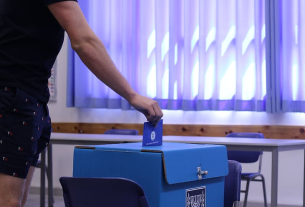In the busy Port of Oxelösund, south of Stockholm, a small orange pilot boat braves the waves and the weather to help incoming vessels manoeuvre into port.
Beneath its unassuming deck, the future of shipping is being put to the test. The boat’s claim to fame is its new engine, powered not by the usual polluting diesel used by many ships, but by methanol, a clean alcohol fuel that is gaining traction as a promising alternative marine fuel.
Shipping accounts for around 3% of global greenhouse gas emissions, according to the International Maritime Organization. Methanol is being considered as a viable alternative, with experts saying it has the potential to reduce shipping emissions by over 80%.
To test this solution, an international team of researchers is developing and demonstrating universal, scalable retrofit kits to enable ships to use methanol across a wide power range (200 kW-4 MW). These tests are part of a joint EU-funded research effort called FASTWATER.
The research team is considering all angles of the transition to methanol as a clean fuel for shipping. This includes retrofitting existing vessels and testing next-generation engines, building a renewable fuel supply chain, liaising with regulatory bodies and training crews to handle the new fuel safely.
This innovation drive to accelerate decarbonisation in the shipping sector brings together a wide range of stakeholders.
Participants include shipyards, a ship owner, engine manufacturers, an equipment supplier, a classification society, a methanol producer, a major European port, as well as research institutes from Belgium, Germany, Greece, Sweden and the UK.
Finding the best fit
One of the challenges in converting shipping to clean energy is the amount of space needed to store sufficient energy to propel a large shipping vessel through the water.
“A key problem of electrification is that the energy density of batteries is quite low. It’s enough to power a car, but you would need to carry an unwieldy number of batteries to power a ship,” said Sebastian Verhelst, a professor of engineering at both Lund University and Ghent University, and FASTWATER coordinator.
“
A very large number of industries are hard to electrify. Shipping is one of them.
“A very large number of industries are hard to electrify. Shipping is one of them,” he said. Verhelst is renowned for pioneering work on renewable-fuel technologies – particularly hydrogen and methanol – in internal combustion engines.
He has also considered hydrogen as an alternative fuel for shipping. Hydrogen has become a popular option for all kinds of hard-to-decarbonise energy needs, from aviation to steel production. According to Verhelst, however, the problem with hydrogen is its low energy density – the amount of energy stored in a certain volume.
“If you wanted to power a ship with it, you would need a very large fuel tank. Methanol, on the other hand, is more compact, which makes it a good option,” he said.
Designing for the future
The FASTWATER team has retrofitted and designed methanol propulsion systems for four different types of vessels to prove methanol’s viability and scalability for sustainable waterborne transport.
In Sweden, the team simply replaced the pilot boat’s diesel engine with a methanol one.
“That meant a number of changes to the ship,” said Albert Wiström of the Swedish Maritime Administration.
A dual-walled fuel system was installed, including a double-skinned methanol tank, double-walled piping, and leak/heat detectors, all integrated into the standard engine room. Beyond the technical adaptations, there were human-related challenges, too.
“We had to retrain the crew”, said Wistrom. “They may have had decades of experience with diesel engines, but now suddenly they had to work with a new fuel.”
In addition to the Swedish pilot boat, the FASTWATER team has designed methanol engines for a German river cruise ship, a Greek coastguard vessel and a harbour tugboat called Methatug.
Belgium’s little green tug
In May 2024, Methatug was presented as a “world first”. Developed with the Port of Antwerp‑Bruges in Belgium, this dual-fuel vessel features engines converted to run on up to 80% methanol.
It stores 12 000 litres (enough for two weeks of operations), and delivers 50 tonnes of bollard pull – all while significantly reducing greenhouse gas, particulate, and emissions of sulphur and nitrogen oxides.
The tug is part of the Port’s greening programme and an important step in its transition to becoming completely climate-neutral by 2050.
“
In theory, we can do a lot with methanol. But green methanol is still only available in limited quantities.
But the dual-fuel engine design was no small feat. “It was very hard to build,” said Verhelst. “We were the first to do it for a tug, which meant we had to figure out a lot of things.”
One key issue they ran into was the safety rules. Methanol is a relatively new fuel for shipping, which means regulations have not caught up with it yet. This created considerable uncertainty for the FASTWATER researchers.
“We hit a wall several times,” said Verhelst. “One area of concern is fire safety. Methanol is more flammable than diesel, so safety standards had to be higher. But we didn’t really know how much higher.”
Still, Verhelst is glad they persevered. By tackling all those challenges, he said, they paved the way for others to follow.
The methanol conundrum: supply vs demand
The Swedish Maritime Administration is keen to retrofit more of its ships with methanol engines, but another issue looms: a shortage of methanol.
For methanol to be truly climate-friendly, it must be green methanol. That means either e-methanol, made from captured CO₂ and renewable hydrogen, or biomethanol, produced from sustainable biomass or waste sources. Both have a much lower carbon footprint compared to traditional methanol, which is typically made from natural gas or coal.
The Swedish pilot boat, for example, is powered by biomethanol produced using wood pulp biowaste from a processing plant in Sweden, thus neatly closing the sustainability circle.
Currently, however, the global supply of green methanol is limited, and scaling up production is a challenge. This bottleneck risks slowing the transition of the shipping industry to low-emission fuels.
EU climate legislation – like the Fit for 55 set of laws designed to fight climate change and cut emissions, and the FuelEU Maritime Regulation that came into force in January 2025, encourages the use of renewable fuels in shipping by setting emissions targets and incentives.
However, supply will need to keep up with demand.
“In theory, we can do a lot with methanol,” said Verhelst. “But green methanol is still only available in limited quantities.” Changes are already on the horizon, though, he acknowledged.
“Large ship operators are beginning to show their commitment to methanol, so hopefully this will lead to significant advances in the near future.”
Research in this article was funded by the EU’s Horizon Programme. The views of the interviewees don’t necessarily reflect those of the European Commission. If you liked this article, please consider sharing it on social media.



